2016 Peugeot Expert VU tow
[x] Cancel search: towPage 216 of 520
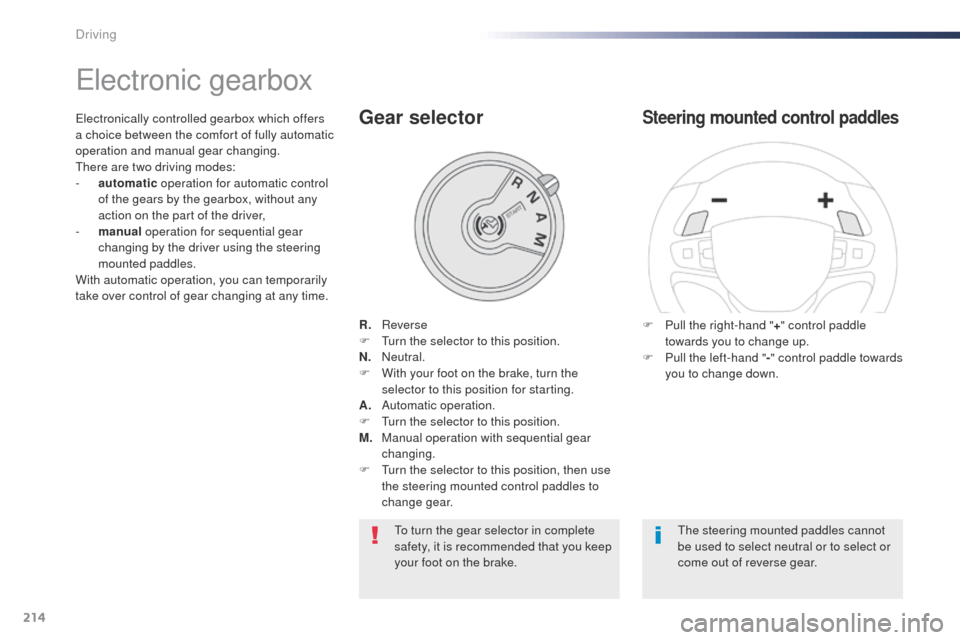
214
electronic gearbox
R. Reverse
F tu rn the selector to this position.
N.
N
eutral.
F
W
ith your foot on the brake, turn the
selector to this position for starting.
A.
A
utomatic operation.
F
t
u
rn the selector to this position.
M.
M
anual operation with sequential gear
changing.
F
t
u
rn the selector to this position, then use
the steering mounted control paddles to
change gear.
Gear selector
F Pull the right-hand " +" control paddle
towards you to change up.
F
P
ull the left-hand " -" control paddle towards
you to change down.
Steering mounted control paddleselectronically controlled gearbox which offers
a choice between the comfort of fully automatic
operation and manual gear changing.
th
ere are two driving modes:
-
a
utomatic operation for automatic control
of the gears by the gearbox, without any
action on the part of the driver,
-
m
anual operation for sequential gear
changing by the driver using the steering
mounted paddles.
With automatic operation, you can temporarily
take over control of gear changing at any time.
th
e steering mounted paddles cannot
be used to select neutral or to select or
come out of reverse gear.
to t
urn the gear selector in complete
safety, it is recommended that you keep
your foot on the brake.
Driving
Page 237 of 520
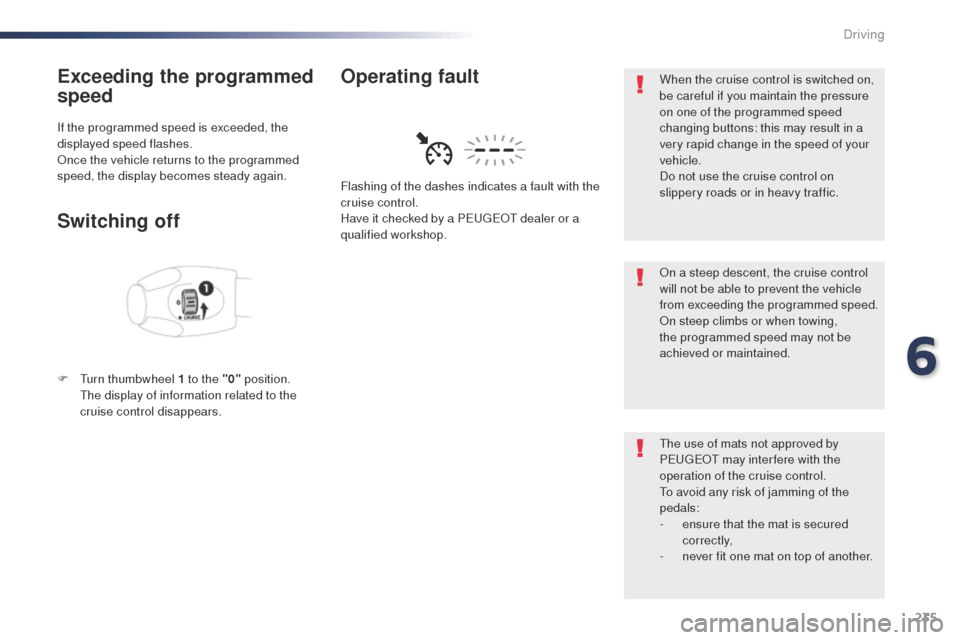
235
Exceeding the programmed
speed
If the programmed speed is exceeded, the
displayed speed flashes.
on
ce the vehicle returns to the programmed
speed, the display becomes steady again.
Switching off
F turn thumbwheel 1 to the "0" position.
th e display of information related to the
cruise control disappears. Flashing of the dashes indicates a fault with the
cruise control.
Have it checked by a P
e
ugeot dealer or a
qualified workshop.
Operating faultWhen the cruise control is switched on,
be careful if you maintain the pressure
on one of the programmed speed
changing buttons: this may result in a
very rapid change in the speed of your
vehicle.
Do not use the cruise control on
slippery roads or in heavy traffic.
on a s
teep descent, the cruise control
will not be able to prevent the vehicle
from exceeding the programmed speed.
on s
teep climbs or when towing,
the programmed speed may not be
achieved or maintained.
th
e use of mats not approved by
P
e
ugeot may inter fere with the
operation of the cruise control.
to a
void any risk of jamming of the
pedals:
-
e
nsure that the mat is secured
c o r r e c t l y,
-
n
ever fit one mat on top of another.
6
Driving
Page 244 of 520
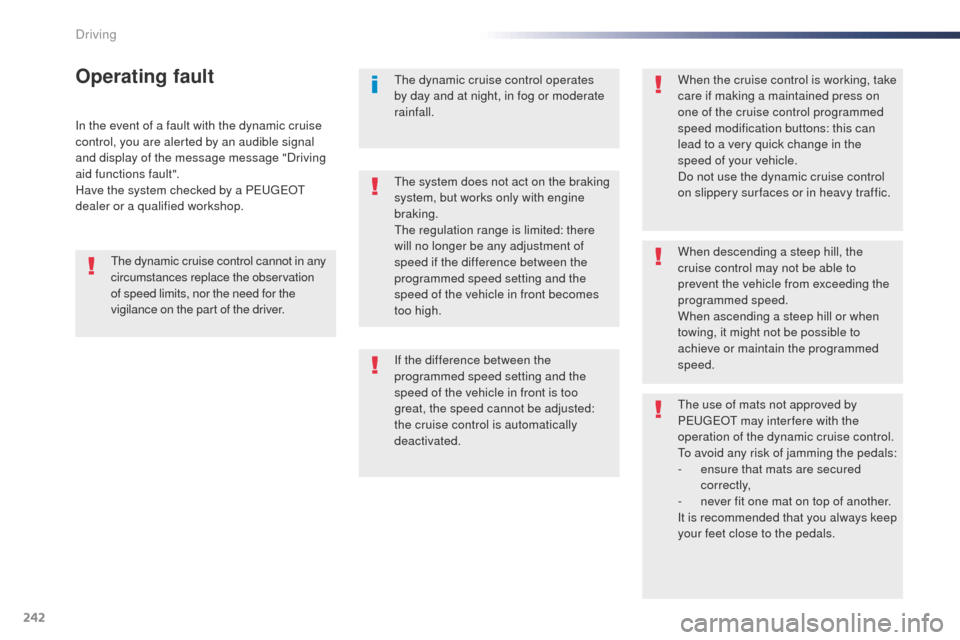
242
In the event of a fault with the dynamic cruise
control, you are alerted by an audible signal
and display of the message message "Driving
aid functions fault".
Have the system checked by a P
e
ugeot
dealer or a qualified workshop.
Operating faultthe dynamic cruise control operates
by day and at night, in fog or moderate
rainfall. When the cruise control is working, take
care if making a maintained press on
one of the cruise control programmed
speed modification buttons: this can
lead to a very quick change in the
speed of your vehicle.
Do not use the dynamic cruise control
on slippery sur faces or in heavy traffic.
When descending a steep hill, the
cruise control may not be able to
prevent the vehicle from exceeding the
programmed speed.
When ascending a steep hill or when
towing, it might not be possible to
achieve or maintain the programmed
speed.
th
e use of mats not approved by
P
e
ugeot may inter fere with the
operation of the dynamic cruise control.
to a
void any risk of jamming the pedals:
-
e
nsure that mats are secured
c o r r e c t l y,
-
n
ever fit one mat on top of another.
It is recommended that you always keep
your feet close to the pedals.
If the difference between the
programmed speed setting and the
speed of the vehicle in front is too
great, the speed cannot be adjusted:
the cruise control is automatically
deactivated.
th
e system does not act on the braking
system, but works only with engine
braking.
th
e regulation range is limited: there
will no longer be any adjustment of
speed if the difference between the
programmed speed setting and the
speed of the vehicle in front becomes
too high.
th
e dynamic cruise control cannot in any
circumstances replace the observation
of speed limits, nor the need for the
vigilance on the part of the driver.
Driving
Page 245 of 520
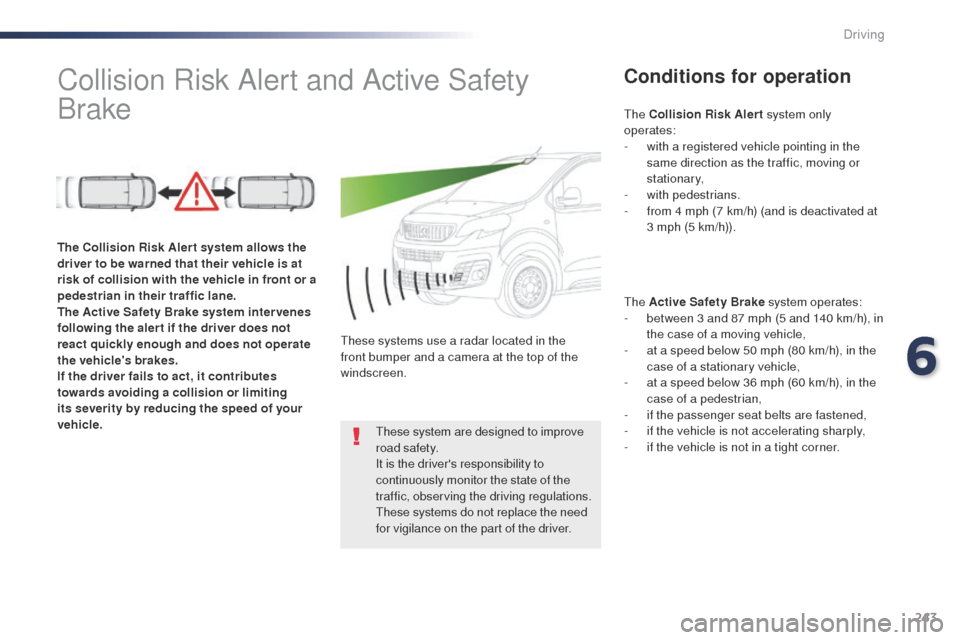
243
Collision Risk Alert and Active Safety
BrakeConditions for operation
the Active Safety Brake system operates:
- b etween 3 and 87 mph (5 and 140 km/h), in
the case of a moving vehicle,
-
a
t a speed below 50 mph (80 km/h), in the
case of a stationary vehicle,
-
a
t a speed below 36 mph (60 km/h), in the
case of a pedestrian,
-
i
f the passenger seat belts are fastened,
-
i
f the vehicle is not accelerating sharply,
-
i
f the vehicle is not in a tight corner.
The
Collision Risk Alert system allows the
driver to be warned that their vehicle is at
risk of collision with the vehicle in front or a
pedestrian in their traffic lane.
The Active Safety Brake system inter venes
following the aler t if the driver does not
react quickly enough and does not operate
the vehicle's brakes.
If the driver fails to act, it contributes
towards avoiding a collision or limiting
its severity by reducing the speed of your
vehicle.
th
ese systems use a radar located in the
front bumper and a camera at the top of the
windscreen.
th
ese system are designed to improve
road safety.
It is the driver's responsibility to
continuously monitor the state of the
traffic, observing the driving regulations.
th
ese systems do not replace the need
for vigilance on the part of the driver.
th
e Collision Risk Alert
system only
operates:
-
w
ith a registered vehicle pointing in the
same direction as the traffic, moving or
stationary,
-
w
ith pedestrians.
-
f
rom 4 mph (7 km/h) (and is deactivated at
3 mph (5 km/h)).
6
Driving
Page 246 of 520
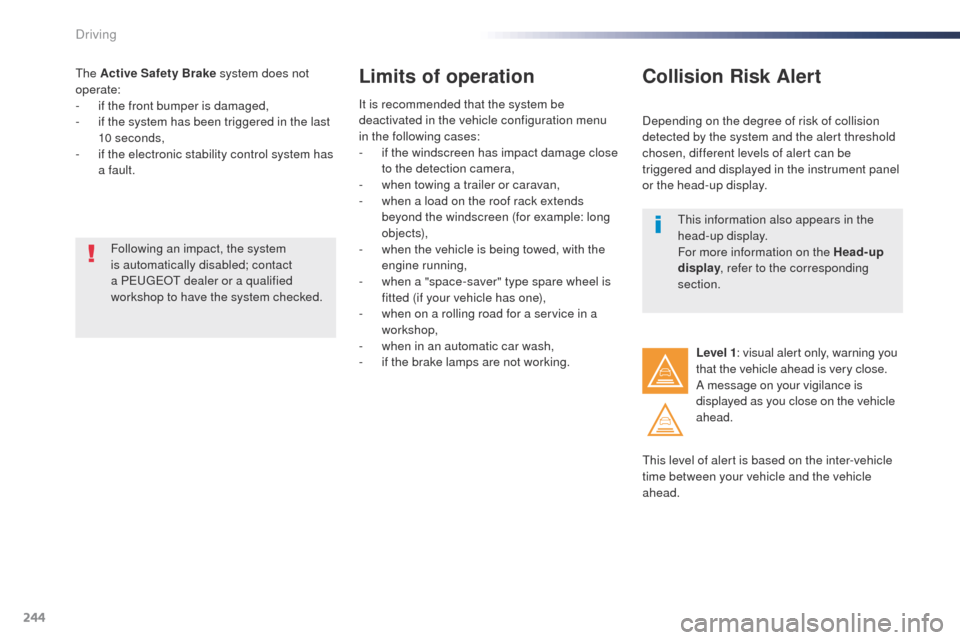
244
the Active Safety Brake system does not
operate:
-
i
f the front bumper is damaged,
-
i
f the system has been triggered in the last
10 seconds,
-
i
f the electronic stability control system has
a fault.Limits of operation
It is recommended that the system be
deactivated in the vehicle configuration menu
in the following cases:
-
i
f the windscreen has impact damage close
to the detection camera,
-
w
hen towing a trailer or caravan,
-
w
hen a load on the roof rack extends
beyond the windscreen (for example: long
objects),
-
w
hen the vehicle is being towed, with the
engine running,
-
w
hen a "space-saver" type spare wheel is
fitted (if your vehicle has one),
-
w
hen on a rolling road for a service in a
workshop,
-
w
hen in an automatic car wash,
-
i
f the brake lamps are not working.
Following an impact, the system
is automatically disabled; contact
a P
e
ugeot
dealer or a qualified
workshop to have the system checked.
Collision Risk Alert
Depending on the degree of risk of collision
detected by the system and the alert threshold
chosen, different levels of alert can be
triggered and displayed in the instrument panel
or the head-up display.
th
is level of alert is based on the inter-vehicle
time between your vehicle and the vehicle
ahead. Level 1
: visual alert only, warning you
that the vehicle ahead is very close.
A message on your vigilance is
displayed as you close on the vehicle
ahead.
th
is information also appears in the
head-up display.
For more information on the Head-up
display , refer to the corresponding
section.
Driving
Page 256 of 520

254
Operating fault
Have it checked by a Peugeot dealer or a
qualified workshop.
th
e system may suffer temporary
interference in certain weather
conditions (rain, hail...).
In particular, driving on a wet sur face
or moving from a dry area to a wet area
can cause false alerts (for example, the
presence of a fog of water droplets in
the blind spot angle is interpreted as a
vehicle).
In bad or wintry weather, ensure that
the sensors are not covered by mud,
ice or snow.ta ke care not to cover the warning zone
in the door mirrors or the detection
zones on the front and rear bumpers
with adhesive labels or other objects;
they may hamper the correct operation
of the system.
Depending on your vehicle's equipment:
With the touch screen
In the Driving
menu, activate/deactivate " Blind
spot monitoring ".
In the event of a fault, these warning lamps
flash.
th
e indicator lamp in this button
flashes and a message appears,
accompanied by an audible signal.
th
e state of the system remains in
memory on switching off the ignition.
th
e system is automatically deactivated
when towing with a towbar approved by
P
e
u g e o t .
High pressure jet wash
When washing your vehicle, do not
place the tip of the lance within 30 cm
of the sensors as otherwise there is a
risk of damaging them.
or
Driving
Page 258 of 520

256
Front parking sensors
As an addition to the rear parking sensors, the
front parking sensors are triggered when an
obstacle is detected in front and the speed of
the vehicle is still below 6 mph (10 km/h).
th
e front parking sensors are interrupted if
the vehicle stops for more than three seconds
in for ward gear, if no further obstacles are
detected or when the speed of the vehicle
exceeds 6 mph (10 km/h).
With the audio system
Deactivation / Activation
Deactivation or activation of the system is done
via the vehicle configuration menu.
th
e sound from the speakers (front or
rear) indicates whether the obstacle is
in front or behind.
th
e system will be automatically
deactivated where a towbar or towbar-
mounted bicycle carrier is fitted
(vehicle fitted with a towbar installed as
recommended by a P
e
ugeot dealer).
In the " Personalisation-configuration " menu,
activate/deactivate " Parking assistance ".
With the touch screen
In the Driving menu, activate/deactivate
" Parking sensors ".
Without audio system
to deactivate the system:
F
P
ress the button, its indicator
lamp comes on, the system is
deactivated.
to a
ctivate the system: F
P
ress this button, the indicator
lamp goes off, the system is
activated
Driving
Page 263 of 520

261
Activation
Activation is automatic on engaging reverse.the function is displayed in the touch screen.
to c
lose the window displayed, press on the
red cross at the top left of the screen.
on d
isplay of the sub-menu, select one of the
four views:
"Standard view".
"180° view".
"Zoom view".
"A
u
to
m
o de".
You can choose the display mode at any time
by pressing on this area. Check the cleanliness of the camera
lenses regularly.
Periodically clean the reversing camera
with a soft dry cloth.
"AUTO mode"
this mode is activated by default.us
ing sensors in the rear bumper, the
automatic view allows a change from the rear
view to the view from above as an obstacle is
approached during a manoeuvre.
th
e system is automatically deactivated
when towing a trailer or carrying a
bicycle on the towbar (vehicle fitted with
a towbar installed as recommended by
the manufacturer).
Quick start mode
this mode displays, as quickly as possible, the
contextual view (left-hand part) and the view
from above the vehicle. High pressure jet wash (if muddy, for
example)
When washing your vehicle, do not
place the tip of the lance within 30 cm of
the camera lenses, as otherwise there
is a risk of damaging them.
A message is displayed advising you to check
your vehicle's surroundings before starting the
manoeuvre.
6
Driving